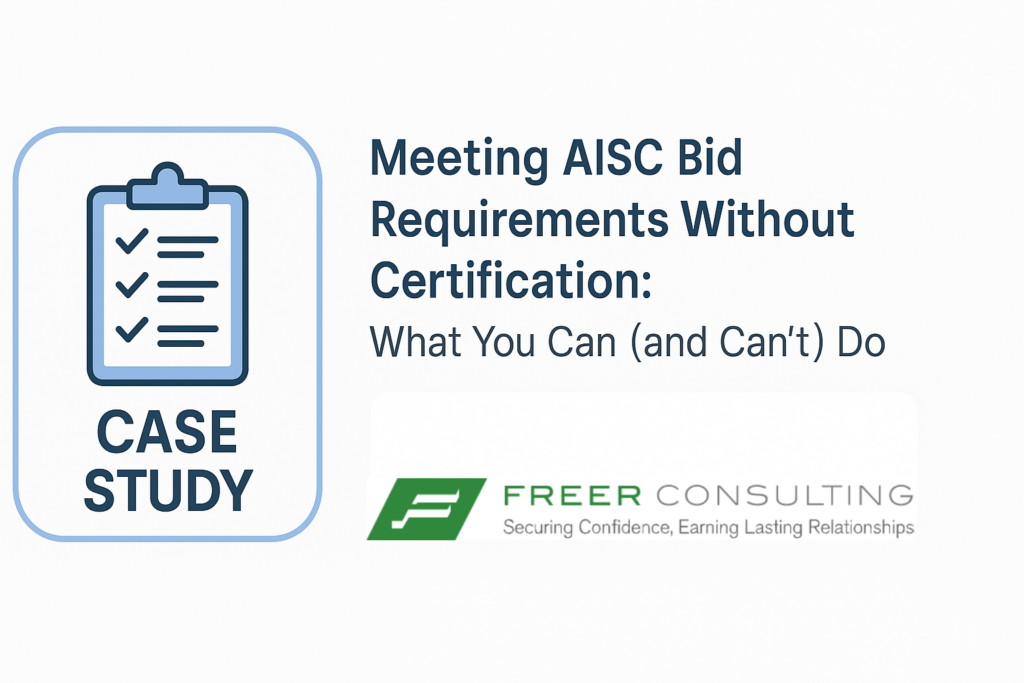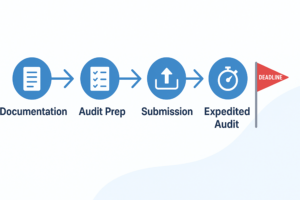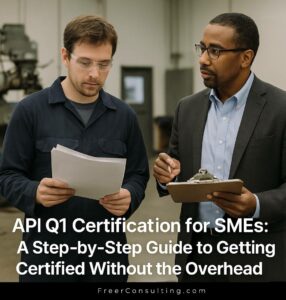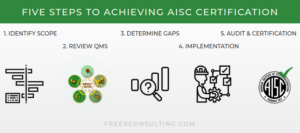What happens when a bid hits your desk that it requires AISC certification but your company isn’t certified yet?
This is a fairly common scenario. Certification requirements often show up in bidding documents for structural steel or bridge projects, even when the timeline to achieve certification realistically exceeds the bid window.
So what can you do if you’re not yet certified – but need to submit a competitive bid?
Here’s how one company navigated that exact situation, with Freer Consulting’s support – and what you need to know about when (and how) a workaround is possible.
Understanding the Bid Language
“Installers, whether the Prime Contractor or Subcontractor, shall be an AISC Certified Erector (CSE) with Bridge Erection Endorsement (BEE) or submit documentation demonstrating equivalent and verifiable qualifications.”
This kind of phrasing opens a strategic window for companies who aren’t yet certified but can show they’re operating at a similar level.
Critically, the language didn’t require current certification as the only path forward. It acknowledged that equivalent qualifications could be considered if they were presented in a credible, structured way.
This distinction created a legitimate pathway for our client to participate in the bid, one that required careful interpretation, clear documentation, and the ability to demonstrate operational readiness in line with AISC standards.
Rather than relying on assumptions, we built a tailored response strategy that addressed the evaluator’s underlying intent: confidence in quality and process control, not just a rubber stamp.
How We Navigated the Requirement
In this case, our client was not yet AISC-certified, but was actively preparing their quality management system in alignment with AISC requirements. Working together, we were able to respond to the bid requirement with structured, credible documentation that demonstrated real readiness.
With the right interpretation of the bid language, we worked closely with the client to build and present a structured response that aligned with the intent of AISC certification — even though the formal certification process had not yet been completed.
Instead of offering generic documentation, we helped the client assemble a tailored package that demonstrated internal readiness, procedural consistency, and a clear path toward compliance. The submission reflected both operational maturity and a credible commitment to full certification.
The reviewing authority accepted the qualifications as meeting the bid criteria. The client was awarded the contract — and is now moving forward with full AISC certification as part of a longer-term strategy.
When This Technique Works
This kind of workaround only works in specific conditions:
- The bid explicitly allows for “equivalent and verifiable” documentation
- The company is genuinely building or has built AISC-aligned systems
- There’s enough documentation to show the system exists – not just a promise
In short, the key is substance, not just intention. Reviewers want to see credible, reviewable evidence of structured processes that align with AISC.
What This Doesn’t Mean
Let’s be clear: this isn’t a permanent fix or a way to “skip” certification.
- It doesn’t apply if the bid requires active AISC certification with no alternatives.
- It doesn’t replace the need for internal audits, training, or system implementation.
- It doesn’t exempt you from scrutiny – reviewers will want real proof.
This strategy buys you time and gets you in the game – but certification still matters and should remain part of the plan.
AISC Certification Is Still the Goal
Winning a bid without certification doesn’t change the long-term need for it. Most contracts will require that certification be completed before work begins, or as a milestone during project delivery.
In this case, we continued working with the client to finalize their procedures, conduct an internal audit, and prepare for the formal AISC application and audit process.
This isn’t a loophole – it’s a bridge strategy for companies already working toward certification under tight timelines.
How Freer Helps
We’ve supported dozens of companies facing tight timelines or unusual bid requirements.
If you’re unsure how to respond to AISC requirements in a bid, we can help you:
- Interpret bid language correctly
- Evaluate whether a documentation-based workaround is possible
- Build out the necessary documentation and structure quickly
- Plan for full certification while maintaining bid eligibility
Final Takeaway
Bidding without AISC certification isn’t always a dealbreaker – but it is a challenge that requires a smart, well-supported response.
If your company is preparing to bid on a project that includes AISC or QP1 language, reach out. We’ll help you determine what’s actually required – and how to respond with confidence.








